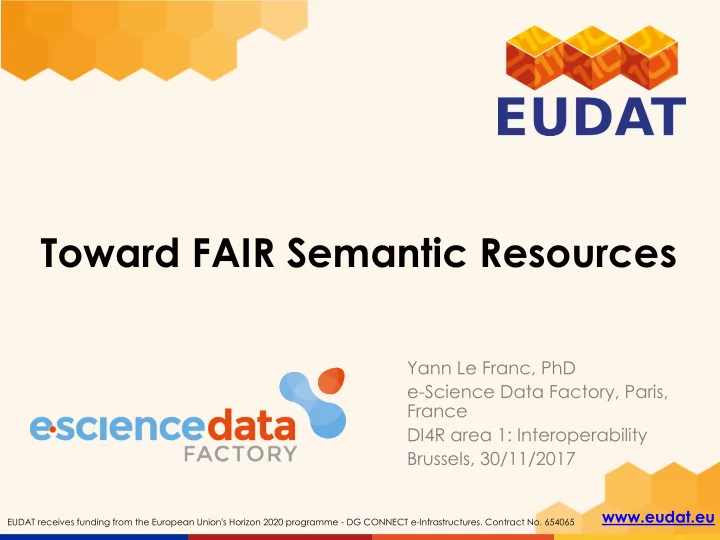

Toward FAIR Semantic Resources Yann Le Franc, PhD e-Science Data Factory, Paris, France DI4R area 1: Interoperability Brussels, 30/11/2017 www.eudat.eu EUDAT receives funding from the European Union's Horizon 2020 programme - DG CONNECT e-Infrastructures. Contract No. 654065
B2NOTE: a Semantic Annotation Service Associate additional information to data elements without changing the data element (W3C Web Annotation standard) Annotation used to retrieve and aggregate data elements from different sources B2NOTE is integrated with EUDAT B2SHARE service B2NOTE can be integrated by external data repositories B2NOTE is a pilot service. Production service will be released in upcoming months.
B2NOTE: a Semantic Annotation Service https://b2note.bsc.es
B2NOTE: a Semantic Annotation Service Creation and management of annotations Three types of annotations: Free text keyword annotation Comment annotation Semantic annotation Autocomplete function using indexed semantic resources
Semantic Index Support term/concept discovery for semantic annotations Build SolR index from Bioportal (434 ontologies and more than 5 millions of concepts) Restricted to biomedical domain How can we extend this approach to other scientific domains ?
Semantic Index Support term/concept discovery for semantic annotations Build SolR index from Bioportal (434 ontologies and more than 5 millions of concepts) Restricted to biomedical domain How can we extend this approach to other scientific domains ? Extension to other domains requires the indexing of more semantic resources
Semantic resources A definition: Individual semantic artifact (Ontologies, Vocabularies, Thesauri,…) and semantic repositories. Landscape evaluation Distributed over the web with limited visibility Different formats (OWL, SKOS, OBO, …) Different metadata descriptions Different repository data models Different APIs
Subjective FAIRness evaluation F indable A ccessible I nteroperable R eusable
Subjective FAIRness evaluation F indable Not easily A ccessible Most of the time I nteroperable No R eusable With limitations
Subjective FAIRness evaluation F indable Not easily A ccessible Most of the time I nteroperable No R eusable With limitations
Identified problems Metadata interoperability API interoperability Discoverability
How can we improve the situation? Community engagement Design and development of a proof-of-concept aggregation service
How can we improve the situation? Community engagement EUDAT Semantic WG Design and development of a proof-of-concept aggregation service Semantic Look Up Service
EUDAT Semantic Working Group
EUDAT Semantic Working Group 45 participants 3 working groups Minimum common metadata for ontologies/vocabularies Interoperability: metadata, data models and API Semantic Marketplace Integration with RDA to support international and multi-disciplinary collaboration
Biodiversity perspective: Lecce meeting
Biodiversity perspective: Lecce meeting Agreement on the issues Need of multi-disciplinary integration of semantic resources for biodiversity Interest for the semantic marketplace: list of functionalities to support ontologists and knowledge engineers
Integration within RDA
Integration within RDA 5 working groups/task forces Topics were selected based on subscription of contributors Task forces outcome and dynamic will be evaluated at the next plenary
Semantic Look Up Service https://bsceudatwp8.bsc.es/ Goldfarb and Le Franc, 2017 – Enhancing the Discoverability and Interoperability of Multi-disciplinary Semantic Repositories; Conference: 2nd International Workshop on Semantics for Biodiversity co-located with 16th International Semantic Web Conference (ISWC 2017), At Vienna, Volume: 1933
Semantic Look Up Service Registration of semantic resources Interface to provide mapping for aligning index with resource data model Publish list of resource Goldfarb and Le Franc, 2017 – Enhancing the Discoverability and Interoperability of Multi-disciplinary Semantic Repositories; Conference: 2nd International Workshop on Semantics for Biodiversity co-located with 16th International Semantic Web Conference (ISWC 2017), At Vienna, Volume: 1933
Semantic Look Up Service Registration of semantic resources Interface to provide mapping for aligning index with resource data model Publish list of resource Wishlist Semi-automated harvesting of the resources Provide analytics on semantic resources Goldfarb and Le Franc, 2017 – Enhancing the Discoverability and Interoperability of Multi-disciplinary Semantic Repositories; Conference: 2nd International Workshop on Semantics for Biodiversity co-located with 16th International Semantic Web Conference (ISWC 2017), At Vienna, Volume: 1933
Aggregating and analyzing multiple sources
Conclusions An active international collaboration of experts has emerged to address the issues preventing FAIR semantic resources Proof-of-concept service: Create and publish a list of multi-disciplinary semantic resources Aggregate semantic resources Provide analytics on the semantic resources Create a multi-disciplinary semantic index What’s next ?
Why should we continue this effort? There is a clear need for semantic services with multi- disciplinary coverage Semantic resources are first class citizen in the implementation of FAIR data management system (FAIR Data Point; Luiz Olavo Bonino da Silva Santos et al., 2016) Needs of communities like Biodiversity and Ecology for aggregating data from multiple disciplines. Needs for Knowledge Engineers/Ontologists to access, aggregate and analyze semantic resources. Luiz Olavo Bonino da Silva Santos et al. (2016) - FAIR Data Points Supporting Big Data Interoperability; In book: Enterprise Interoperability in the Digitized and Networked Factory of the Future, Publisher: ISTE Press, Editors: Martin Zelm, Guy Doumeingts, Joao Pedro Mendonça, pp.270-279
What would be the outcomes? A central hub for ontologist and knowledge engineers to access multi-disciplinary semantic resources and analytics. A multi-disciplinary curated semantic index that can be used by semantic tools (annotators, text miner,…) A set of recommendations and standards to ease the interoperability of semantic resources. Potential business applications that would guarantee the sustainability of the resources.
What do we need? Community support Strategical positioning Financial resources
What do we need? JOIN US in the RDA IG Community support How can we Strategical positioning integrate this work in the EOSC vision ? How can we fund Financial resources the development of the semantic index ?
What do we need? JOIN US in the RDA IG Community support How can we Strategical positioning integrate this work in the EOSC vision ? How can we fund Financial resources the development of the semantic index ? Your inputs
Acknowledgements EUDAT: Doron Goldfarb, Barbara Magagna, Aymeric Rodriguez RDA: Simon Cox, Adam Shepherd, John Graybeal The experts who are contributing to the RDA VSIG The experts who did contribute to shape this project in Barcelona and in Lecce.
Recommend
More recommend